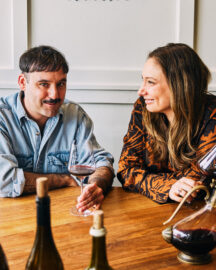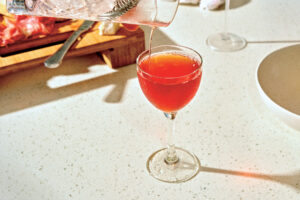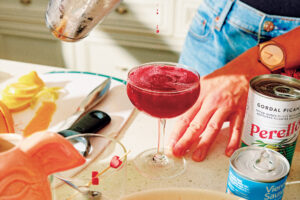Calgary Chef Sean MacDonald of Market Restaurant was recently named the winner of the S. Pellegrino Young Chef 2016 finals for his dish “Duck and Carrot.”

The win has earned him a spot in the final competition for the title of S.Pellegrino Young Chef 2016 in Milan on October 13th. MacDonald’s winning dish is comprised of pan-roasted duck breast, brined in fennel juice and served with caramelised carrot, pickled fennel, roasted date jam, and star anise jus and the extraordinary Normand Laprise will be helping MacDonald finesse his creation in the lead-up to October 13th.
We caught up with Chef MacDonald to talk inspiration, find out what he’s cooking now, and get the recipe for Duck and Carrot.
C100B: What was the inspiration behind your dish?
SMD: This dish was inspired by my Grandpa. My Grandpa and I are very close, and I wanted to create a dish that incorporated his favourite foods.
C10oB: How did Duck and Carrot evolve from concept to final execution?
SMD: My Grandpa loves duck, and like a stereotypical grandparent, he always has candies in his pocket. Every time I see him, he pulls out a handful and asks me me to choose one. Caramel and liquorice candies are a staple for him, so I wanted to pay homage to him in this dish. I knew the flavours of duck, caramel and liquorice would compliment each other nicely. For the caramel component, I wanted to capture the flavours without actually using caramel or sugar. I opted for naturally sweet ingredients, cooking carrots in their own juices, charring them, then dehydrating them to a “soft caramel” texture. Through this process, the flavour of the carrot tastes almost identical to caramel. Next, I added a roasted date jam to create depth and elicit a deep caramel flavour. I incorporated honey in my jus for a burst of sweetness, and to match the tangy flavour I wanted to achieve. For a liquorice flavour, I simply added fennel and star anise. To keep these flavours fresh, I used pickled fennel bulb and raw shaved fennel stalk. To add complexity to the sauce, I steeped star anise in the jus. I then brined the duck in fennel juice to bring a light liquorice flavour to the protein.
C100B: What dish are you working on now?
SMD: I recently created a fried broccoli dish for our summer menu. We wanted a tasty side dish that people would come back craving. We quickly fry broccoli just enough to keep an el dente crunch in the florets and to crisp the outside. After frying the broccoli, we toss it in lemon juice and salt. We squeeze dots of Serrano pepper and prawn aioli around the broccoli, then finish the dish by placing pecorino crisps on top. It’s a beautiful, fresh side for summer. There are varying textures and complimentary flavours of shellfish, spice, and acidity.
C100B: Where do you see yourself in years to come?
SMD: I am very thankful to have been selected to participate in the S. Pellegrino Young Chef 2016 event. I can’t begin to explain how lucky I feel to be representing Canada in Milan this October. The Canadian Regionals was one of the best experiences I’ve ever had, and I can’t wait to work with Chef Normand Laprise to refine my dish and hone my skills. Soon I hope to head to Europe to work abroad for a few years to continue learning and growing. I would love to work towards earning a Michelin Star someday. In the future, I see myself owning a restaurant and designing it in a way that aligns with my culinary values and ambitions.
Duck and Carrot Recipe:
For the duck breast brined in fennel juice
• Duck Breast 1000g (about 3 or 4 breasts or 2 whole ducks)
• Fennel bulbs and stalks 600g
• Brown sugar 70g
• Salt 70g
• Water 500g
• Ice 500g
• Fennel seeds 5g
• Bay Leaf 5g
• Cinnamon stick 5g
Preparing the duck breast:
Brine: Juice fennel bulbs and stalks through a juicer and reserve juice. In a cast iron pan, toast the fennel seeds until aromatic and have color. Combine the seeds with the juice. In a medium sized pot, combine the water, salt and brown sugar. Place the pot over high heat and bring up to a simmer or until all the salt and sugar are dissolved. Place ice in a separate container (container big enough to contain ice and all of the ingredients). Pour the hot sugar and salt water over the ice. Add the fennel juice and seeds and stir to combine all ingredients.
Prepping the duck: Break down the whole ducks. Separate the breasts and legs from the carcass. Reserve the bones for the stock and save the legs for another use. Clean the duck breasts; removing the silver skin and tenderloins. Clean up the fat on the duck breast.
Brined, then pan roasted duck breast: Place the duck breasts in the brine (make sure the breasts are completely covered in the brine except for the skin). Leave the breasts in the brine for 2 hours. Line a resting rack with a food service cloth and place on a baking tray. Once the breasts have brined for 2 hours, lay them out skin side up on the resting rack. Pat the skins of the ducks dry with a cloth. Place the rack in the fridge to dry out for about an hour or more (until the duck skins have hardened and are completely dry).
Cooking the duck: Place a dry, non-stick pan over high heat. Do not oil the pan. Season the skins of the ducks and wait for the pan to start to smoke. Once the pan is smoking, place the duck breasts skin-side down in the pan. Place another pan or weight on top of the duck breasts to press the skin flat in the pan. Wait about a minute or two, until the skin starts to sear, then turn the heat down to very low. Leave the duck breasts for about five minutes before removing the pan or weight off of them. Once the weight is removed, let the ducks cook skin side down until most of the fat has rendered out from underneath the skin and the visible flesh has slightly cooked (about 20 minutes). Press on the breasts to make sure they are cooked to slightly under medium rare. Once the breasts have reached this point, flip them in the pan and cook on the flesh side for about thirty seconds. Place all the duck breasts on a resting rack with the skin side up. Leave them to rest for ten minutes. When ready to plate the dishes, gather a cutting board and sharp knife. Place the ducks skin side down on the cutting board and slice them vertically down the middle. Trim the uncut side to create a flat edge to present the duck breasts flesh side up. To warm the duck before plating, place the breasts on a flash pan. Put the flash pan in the oven set at 400 degrees F for about a minute.
Duck stock:
• Duck bones 4000g
• Star anise 10g
• Onion 400g
• Carrot 200g
• Bay leaf 5g
• Water 10L
Place the duck bones in a high edged roasting pan and place in an oven at 350 degrees F. Once the bones have roasted and turned a golden brown color, pull them out. Place the bones in a large pressure cooker. Add water to the hot roasting pan and scrape the cooked bits from the pan. Pour the scraped bits and water into the pressure cooker with the bones. Clean the skin off the onions and cut in half. Place a cast iron pot over high heat and wait until it starts to smoke then add oil. Place the onions cut face side down in the pan. Char the onions until dark brown/ black color. Once the onions are charred, add them along with the star anise, bay leaf and carrot into the cooker. Cover the bones with cold water, latch lid on pressure cooker and place over medium-high heat. Wait for the pressure to build up to the desired amount and cook for 45 minutes. Remove the pressure cooker from the heat and run under cold water. Remove the weight off the spout and wait for all of the air to release. Take the lid off the cooker. Strain the stock, reserving the liquid and discard the bones and vegetables. This process can also be done the classic way in a stock pot, by cooking the stock for at least 2 hours.
Star anise jus:
· Duck Stock 16L
· White wine 500g
· Dates 50g
· Onion 100g
· Star anise 10g
· White wine vinegar 300g
· Honey 25g
Place the stock in a large pot over medium high heat. Wait for the stock to come to a medium simmer. Continually skim the stock to get rid of fat and impurities. Julienne the onion and remove the pits from the dates. In a medium sized pot add the onions and dates to sauté. Add the star anise into the pot. Sautee the ingredients until the onions have become soft and the star anise is floral (about 15 minutes). Remove the ingredients from the pot and reserve. Pour the white wine vinegar into the pot and reduce until about 20 ml remains. Then add the white wine and reduce until you have a combined amount of about 100 ml. Add the honey and again add the sautéed onion, dates and star anise. Once the stock has reduced to about 1 liter, pour it into the medium pot with all the other ingredients. Simmer everything on low for about 10 minutes and skim the impurities. Strain everything through a chinois lined with a fryer filter. Season and reserve jus until plating.
Carrot puree:
· Carrot 600g
· Butter 250g
· White wine vinegar 2g
· Xanthan gum 2g
· Salt 8g
Scrub the carrots, removing all the dirt. Cut the carrots very thinly to improve the overall cook of the puree. In a medium sauce pot, add the butter and place over medium heat. Allow the butter to melt fully, then add the cut carrot. Turn the heat down to low and cover with a lid. Occasionally stir the ingredients. Once the carrots are thoroughly cooked and soft, about 25 minutes, transfer the components in the pot to a Vitamix. Puree the ingredients until smooth. Season the puree with salt and a splash of white wine vinegar then pass it through a chinois. Reserve in a small sauce pot covered with plastic wrap until ready to plate.
Par-poached Carrot:
• Organic Baby Carrot 1200g
• Butter 10g
• Salt 3g
Preheat the oven to 500 degrees F. Scrub the skin of the carrots, removing all dirt. Juice enough carrot to produce 600g of carrot juice. Once you have the juice, pour it into a medium pot and reduce it by half. Take the whole carrots and place them in the pot of reduced carrot juice. Add a pinch of salt and shallow poach the carrots on low heat. Poach for about ten minutes, barely cooking the carrots. Remove the carrots from the pot, reserve the reduced juice and place the carrots on a baking tray lined with parchment paper. Place the baking tray in the oven for about 12 minutes. The skin of the carrots should be a dark caramelized color. Remove the carrots from the oven and leave on a rack and roll to cool. Turn down the oven to 200 degrees F. Once the internal temperature of the oven has come down to 200, place the tray of carrots back in the oven. Dehydrate the carrots in the oven for the next two hours or more, until the carrots have reduced in size by about 25%. Every half an hour brush the carrots with the reduced carrot juice to concentrate the carrot flavor and add to the caramelization. Once the carrots are done, pull out of the oven and reserve until ready to plate. Once the dish is ready to plate, warm the carrots up in a pan with the butter and deglaze with reserved carrot juice. Season them with salt.
Pickled fennel:
• Organic Fennel bulb 300g
• White wine vinegar 150g
• Water 80g
• Orange Juice (1 Orange)
• Honey 2g
• Salt 5g
Cut the stalks from the bulbs of fennel. Reserve the stalks for later. Take the bulbs and cut them vertically into quarters. Using a mandolin, slice the fennel very thinly, producing a half dissection of the bulb. Place the sliced fennel in a vac pac bag. In a separate bowl, combine the vinegar, orange juice, water, honey and salt. Stir to dissolve. Pour the pickling liquid into the bag of sliced fennel. Vacuum seal the bag to quick pickle the fennel. Place the bag of vacuum sealed fennel in the fridge and reserve until needed to plate.
Preparing raw fennel and fennel fronds:
Take the stalks of fennel you reserved from the pickled fennel. Pick the fronds off the stalks and reserve the fronds in cold water until needed to plate. Slice the stalks horizontally, very thinly on the mandolin. Reserve in cold water until needed to plate.
Roasted date jam:
• Medjool Dates 600g
• Water 100g
• Xanthan gum 2g
• Salt 5g
Preheat the oven to 400 degrees F. Pit the dates and place them on a small baking tray lined with parchment paper. Season the dates and place in the oven. Roast for about 15 minutes until the dates have caramelized and softened. Place the dates in the Vitamix along with the water. Mix on high until smooth. Season to taste and reserve for plating.
Duck and Carrot photo: Katerine Holland
Share: Facebook, X (Formerly Twitter)













